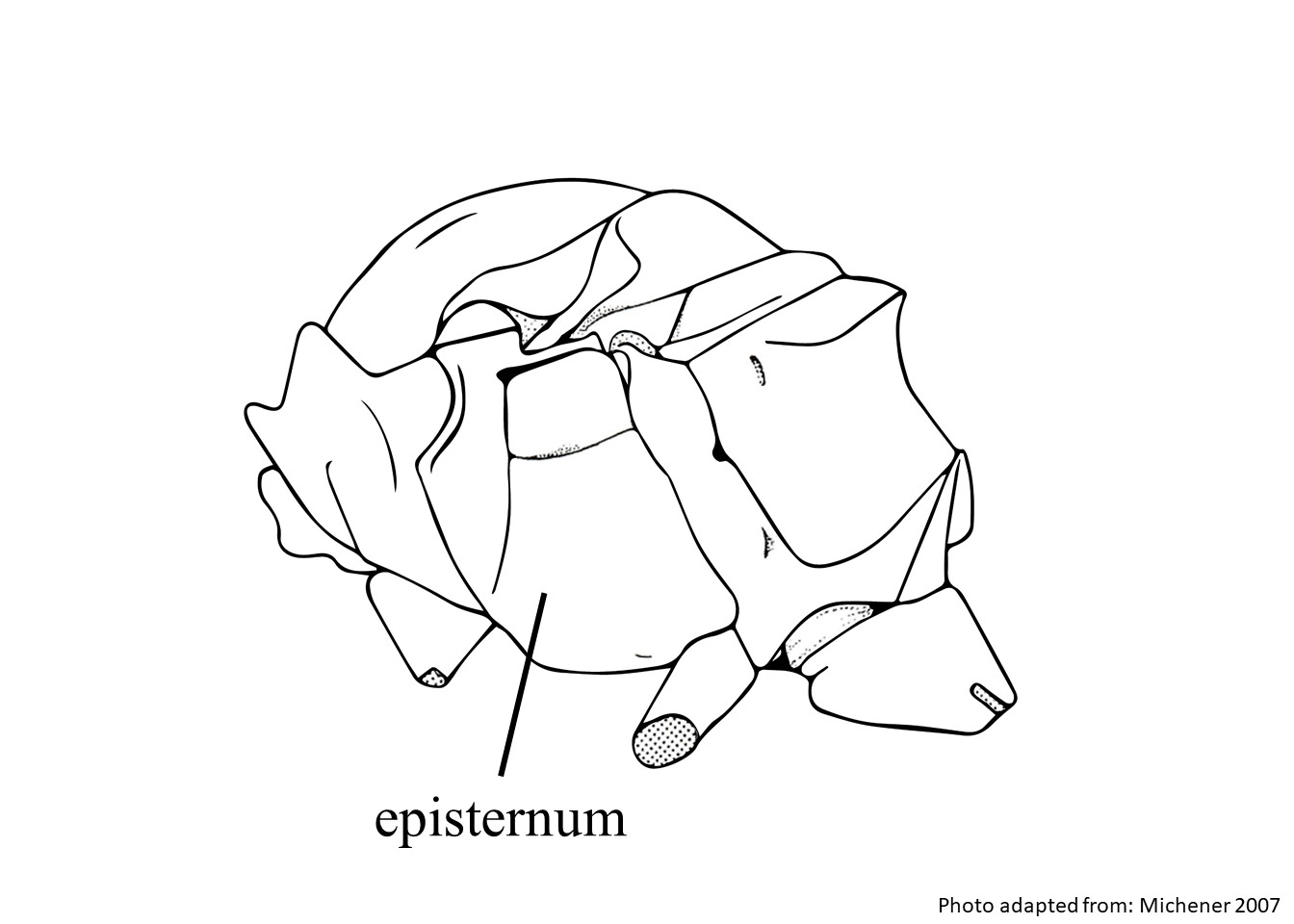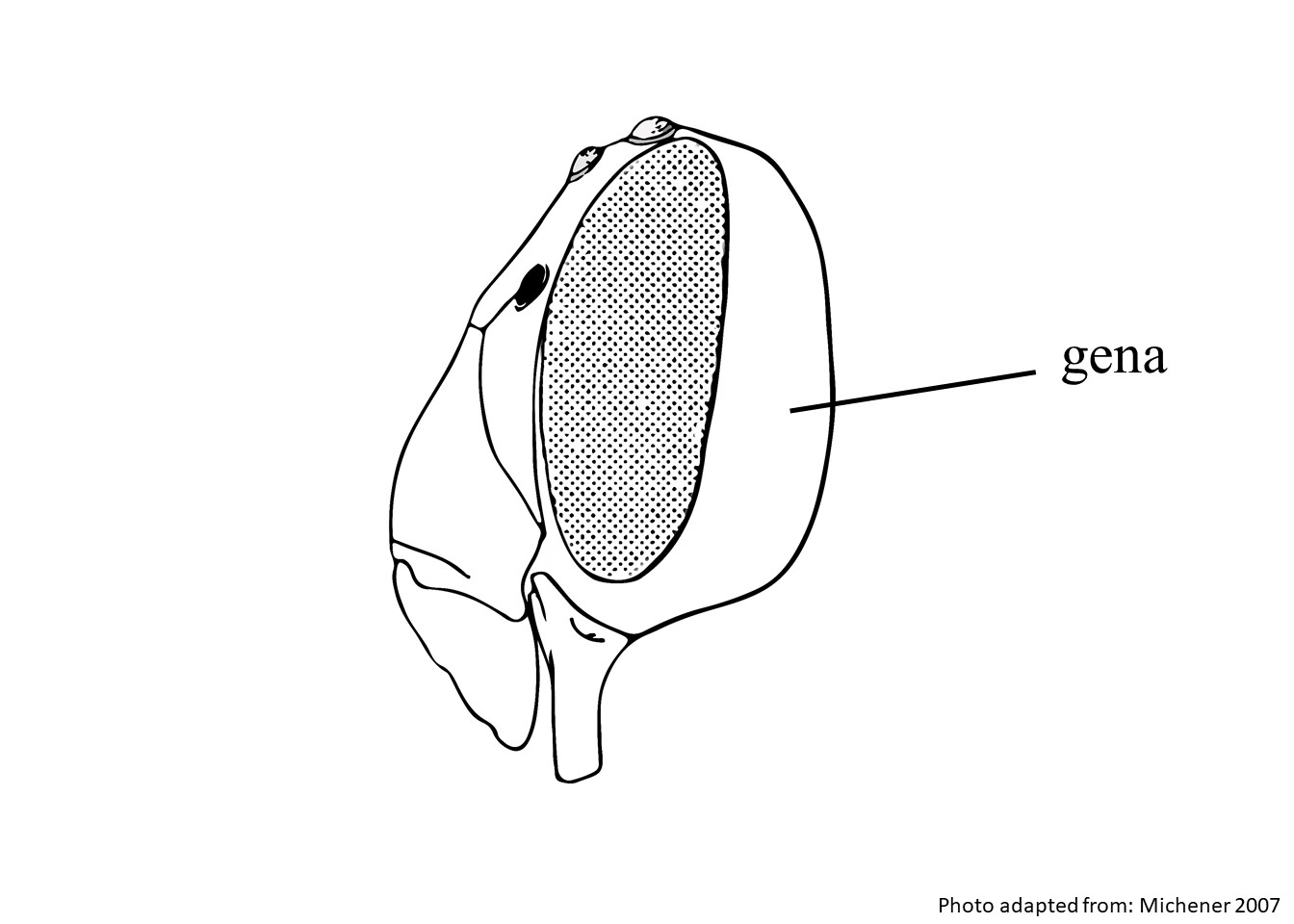Family: Megachilidae
Subfamily: Megachilinae
Tribe: Osmiini
Genus: Osmia Panzer, 1806
Subgenus: O. (Osmia) Panzer, 1806
Species: Osmia pedicornis Cockerell, 1919
Common name: none
Osmia pedicornis are black bees with a slightly blue or green luster to the thorax and abdomen (Wu 2006Wu 2006:
Wu, Y. 2006. Hymenoptera: Megachilidae. Fauna Sinica, Insecta. Vol. 4. Science Press, Beijing.). Females have long, upright, white hair mixed with black and brown long hairs on the head; the scutumscutum:
the large segment on top of the thorax located between the wings and behind the head
has intermixed black and yellow-brown hairs; and the episternumepisternum:
the lateral or side areas of the thorax, excluding the lateral surfaces of the propodeum
 has primarily pale hair (Fig 2). T1–T2 have yellow-brown hair, and T3–T5 have dark brown or black hair (Wu 2006Wu 2006:
has primarily pale hair (Fig 2). T1–T2 have yellow-brown hair, and T3–T5 have dark brown or black hair (Wu 2006Wu 2006:
Wu, Y. 2006. Hymenoptera: Megachilidae. Fauna Sinica, Insecta. Vol. 4. Science Press, Beijing.). Males have dull yellowish hair with a mixture of black on the head, thorax, and legs (Yasumatsu and Hirashima 1950Yasumatsu and Hirashima 1950:
Yasumatsu, K. and Hirashima, Y. 1950. Revision of the genus Osmia of Japan and Korea (Hymenoptera: Megachilidae). Mushi (Fukuoka) 21: 1ndash;18.). Female body length is 15–17 mm, and male body length is 10–11 mm (Wu 2006Wu 2006:
Wu, Y. 2006. Hymenoptera: Megachilidae. Fauna Sinica, Insecta. Vol. 4. Science Press, Beijing.). O. pedicornis is used commercially as an apple tree pollinator in Japan (Kitamura and Maeta 1969Kitamura and Maeta 1969:
Kitamura, T. and Y. Maeta. 1969. Studies on the pollination of apple by Osmia . III. Preliminary report on the homing ability of Osmia cornifrons (Radoszkowski) and O. pedicornis Cockerell. Food and Agricultural Organization of the United Nations.).
(modified from Wu 2006Wu 2006:
Wu, Y. 2006. Hymenoptera: Megachilidae. Fauna Sinica, Insecta. Vol. 4. Science Press, Beijing.)
 without apicalapical:
without apicalapical: 1.5 times wider than the eye in laterallateral:
1.5 times wider than the eye in laterallateral: very large, usually covering S3S3:
very large, usually covering S3S3: to S5S5:
to S5S5: .
. without median apicalapical:
without median apicalapical: usually apicallyapically:
usually apicallyapically:Osmia pedicornis look similar to O. rufina and O. bicornis. Females of these species all have laterallateral:
relating, pertaining, or attached to the side
horns and bidentatebidentate:
having two teeth
median apicalapical:
near or at the apex or end of any structure
projection on the clypeusclypeus:
a section of the face below the antennae, demarcated by the epistomal sutures. O. pedicornis can be differentiated by the bifurcatebifurcate:
divided into two branches; forked
apexapex:
end of any structure
of the laterallateral:
relating, pertaining, or attached to the side
horns of the clypeusclypeus:
a section of the face below the antennae, demarcated by the epistomal sutures. Males are similar in size and hair color and can be difficult to distinguish without dissecting them to see the genitaliagenitalia:
all the genital structures collectively
and hidden sternasterna:
the plates on the underside of the abdomen, often abbreviated when referring to a specific segment to S1, S2, S3, S4, S5, S6, S7, or S8
 . They can, however, be distinguished by the shape of S8S8:
. They can, however, be distinguished by the shape of S8S8:
the plates on the underside of the abdomen, often abbreviated when referring to a specific segment to S1, S2, S3, S4, S5, S6, S7, or S8
 and the apexapex:
and the apexapex:
end of any structure
of the gonocoxites.
Osmia pedicornis adults have been recorded in flight between March and June with the majority of specimens recorded through April and May (GBIF 2019fGBIF 2019f:
GBIF.org. 19 June 2019. GBIF Occurrence Download. https://doi.org/10.15468/dl.xi3aul).
Osmia pedicornis collect pollen from flowers that produce little to no nectar (Quest 2009Quest 2009:
Quest, M. 2009. Arbestand, okologie und habitatwahl von bienen ausgewahlter offenlebensraume im lazovski zapovednik (ferner osten russland). Entomofauna (ansfelden), supplement 15: 1ndash;357.). O. pedicornis is known to be a generalist, collecting pollen from Rosaceae, Geraniaceae, Caprifoliaceae, Elaeagnaceae, and Fabaceae (Quest 2009Quest 2009:
Quest, M. 2009. Arbestand, okologie und habitatwahl von bienen ausgewahlter offenlebensraume im lazovski zapovednik (ferner osten russland). Entomofauna (ansfelden), supplement 15: 1ndash;357.).
Osmia pedicornis nests can be found in cracks within bark or rotten wood, crevices between twigs and stalks, under stones, or inside cracks in soil (Maeta 1978Maeta 1978:
Maeta, Y. 1978. Comparative studies on the biology of the bees of the genus Osmia of Japan, with special reference to their managements for pollinations of crops (Hymenoptera: Megachilidae). Bulletin of the Tohoku National Agricultural Experiment Station. 57: 195ndash;209.). Nesting habit will be typified by the abundance of nesting sites; cell partitions and plugs are composed of leaf pulp or mud (Maeta 1978Maeta 1978:
Maeta, Y. 1978. Comparative studies on the biology of the bees of the genus Osmia of Japan, with special reference to their managements for pollinations of crops (Hymenoptera: Megachilidae). Bulletin of the Tohoku National Agricultural Experiment Station. 57: 195ndash;209.). O. pedicornis will forage up to 700 meters from their nesting site (Maeta 1978Maeta 1978:
Maeta, Y. 1978. Comparative studies on the biology of the bees of the genus Osmia of Japan, with special reference to their managements for pollinations of crops (Hymenoptera: Megachilidae). Bulletin of the Tohoku National Agricultural Experiment Station. 57: 195ndash;209.).
Osmia pedicornis specimens have been recorded in eastern China and Japan (Yasumatsu and Hirashima 1950Yasumatsu and Hirashima 1950:
Yasumatsu, K. and Hirashima, Y. 1950. Revision of the genus Osmia of Japan and Korea (Hymenoptera: Megachilidae). Mushi (Fukuoka) 21: 1ndash;18.). O. pedicornis known habitats are coastal meadows (Quest 2009Quest 2009:
Quest, M. 2009. Arbestand, okologie und habitatwahl von bienen ausgewahlter offenlebensraume im lazovski zapovednik (ferner osten russland). Entomofauna (ansfelden), supplement 15: 1ndash;357.).
Distribution map generated by Discover Life -- click on map for details, credits, and terms of use.
GBIF.org. 19 June 2019. GBIF Occurrence Download https://doi.org/10.15468/dl.xi3aul.
Haider, M., Dorn, S., Sedivy, C. and Müller, A. 2014. Phylogeny and floral hosts of a predominantly pollen generalist group of mason bees. Biological Journal of the Linnean Society. 111: 78-91.
Maeta. Y. 1978. Comparative studies on the biology of the bees of the genus Osmia of Japan, with a special reference to their managements of pollinations of crops (Hymenoptera: Megachilidae). Bulletin of the Tohoku National Agricultural Experient Station. 57:195-209.
Quest, M. 2009. Artbestand, Ökologie und Habitatwahl von Bienen ausgewählter Offenlebensräume im Lazovski Zapovednik (Ferner Osten Russland). Entomofauna (Ansfelden), Supplement 15: 1-357.
Wu, Y. 2006. Hymenoptera: Megachilidae. Fauna Sinica. Insecta 44: 1-474.
Yasumatsu, K. and Hirashima, Y. 1950. Revision of the genus Osmia of Japan and Korea (Hymenoptera: Megachilidae). Mushi (Fukuoka) 21: 1-18.